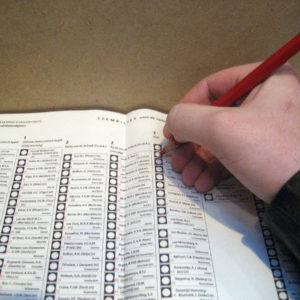The constant stream of alarming headlines keeps all eyes on the top of the ticket — but when it comes to immediate impacts on your family and community, the most important names on the ballot just might be the ones you’ve never heard of.
Of course, the choice between another season of the Trump show and a Biden presidency is the most consequential decision for the nation as a whole, particularly as we combat the resurging coronavirus.
But by the time any changes in Washington make a real difference where you live, your local school board will have already made decisions that have real consequences for your daily life.
The race with the biggest immediate impact on the health, economics and families in your community is in your own backyard. Or, more accurately, the schoolyard.
When schools closed their doors this spring, life for millions of people was drastically altered. Kitchen tables became classrooms, and studio apartments became Zoom teaching studios.
This fall, school is still far from normal, and whether nearby public schools are open for in-person instruction has massive consequences for students and teachers, their families, and the local economy.
At the start of the school year, about 40 percent of public schools offered an option for full time in-person instruction, and another quarter offered a hybrid schedule or part-time in-person instruction.
The remaining 34 percent of schools started fully remote this fall, leaving approximately 15 million students with no option for in-person learning, and many parents with an impossible load to bear.
This, even as schools that did open showed few signs that they are spreading the virus.
What do school closures have to do with Election Day?
A lot, because those reopening decisions aren’t static and the school board members that oversee them are on the ballot. Even by October 1, a third of schools that began the year remotely had made a shift towards more face-to-face classroom instruction.
That reopening trend is now running up against the coming winter and a long-predicted resurgence of the virus, and the game of tug-a-war between pressure to reopen and cries to close schools will continue for the remainder of the school year.
The school board members you elect November 3rd will have a significant role in deciding whether, and how, schools open or close throughout the spring, and even beyond.
Now, if you can’t name whoever is running for your local school board, you are not alone. In a normal year, 80 percent of poll respondents weren’t sure they could name their school board member either.
But as COVID-19 sweeps the nation, it’s never been more important to learn those names, and find out how they promise to manage schools during the pandemic.
After all, what your life looks like for the foreseeable future comes down to whether board members have the courage to send kids back to school when it’s safe to do so, and the wisdom to do it safely when they do.
What does this mean for you? Well, it means you should take a few minutes to get to know your local school board candidates before you vote.
Granted, these candidates can be difficult to evaluate.
The issues separating them are not well understood by many voters, they don’t always have campaign websites, and the typical mental shortcut of voting party line won’t cut it, as school board candidates don’t run under a particular political party’s banner in most states.
However, this year the differences should be much easier to spot.
Candidates should be explicit about how they will weigh closures throughout the pandemic.
If they can’t give you a compelling rationale for how they will steer your local public schools, one that balances precautions against the virus with substantial educational implications for students and economic implications for your community, don’t vote for them.
Beyond this, the candidate you vote for should support the values that you and your community hold. Remember that they will oversee how schools teach civics and history, maintain high standards, fairly administer disciplinary policies, and ensure a joyful and supportive school culture for children.
Add the pandemic to this list, and it’s obvious that it is worth your time to make sure you’re not blindly choosing from a list of unfamiliar names when you reach the bottom of your ballot.

